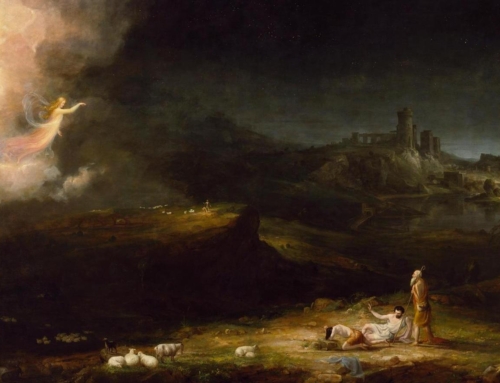Before we begin our tour of the Book of Revelation itself in the next post, it is fitting that we take a look at a couple of points that will save a lot of explanation later on, then take stock of what we’ve learned so far.
1. Symbolic Numbers
2. Narrative flow—Recapitulation
1. The Book of Revelation is full of symbolic numbers. Since we have seen that Revelation is a book of prophetic visions, the elements of which are symbols of spiritual realities, it makes sense that the numbers present in the book would be symbols of something else, not just random quantities.
Even outside prophetic visions, symbolic numbers are an ordinary part of the speech patterns in the Old Testament. The ancient Hebrews habitually used numbers to mean something other than their quantitative value. It doesn’t mean that they were foolish or dishonest; it just means that those were the conventions of speech that they used. We, on the other hand, would be foolish to ignore these conventions when reading a book that presumes knowledge of them, as Revelation does.
For instance, besides the quantitative meaning that the numbers could have, three can mean “a few” and five can mean “several.” Seven and ten are numbers of completeness and perfection. Twelve means “all Israel.” A thousand means “very many, an indefinitely large amount.” Forty has associations of ascetic purification and encounter with God, going back to Noah and Moses.
There are other numbers less commonly known but also important. One of them is from the Book of Daniel. Historically, the persecution that the people of God suffered at the hands of Antiochus Epiphanes IV lasted for about three and a half years. This was such an intense and memorable persecution that “three and a half years” became a symbolic way of saying “persecution by the enemies of God,” regardless of the duration of the persecution. Even as a quantitative unit, “three and a half years” could be expressed in a variety of ways: “a time, two times, and a half time,” or “one thousand three hundred thirty-five days,” or “one thousand two hundred ninety days,” or the other similar formulas found in Daniel 12 and Daniel 7 (keep in mind that with their lunar calendar and its intercalary months they weren’t as nitpicky about calendric calculations as we are, in addition to being less accountant-like about numeric quantities to begin with).
This is not as strange as it might seem at first glance—we do the same thing in our culture today. For instance, the terrorist attack on September 11, 2001, was so memorable to us that the numbers “9” and “11” used together now can be used without explanation among Americans as a synonym for “terrorist attack on our land” or even “unspeakable tragedy.” All someone has to do is say “9/11” and a whole host of associations comes flooding back to us. Likewise if someone were to speak of “another 9/11,” we would all know what he meant, and we wouldn’t necessarily expect that it would have to happen on that exact calendar date.
2. Narrative flow – Recapitulation
“Recapitulation” can mean either a break in the action to discuss something that happened earlier, or it can mean starting the story over again and presenting it from the beginning in a different way. Both of these happen often in the Bible, and both techniques are used in the Book of Revelation. I would like to focus especially on the second one.
One of the biggest, most classic mistakes people make with the Book of Revelation is assuming that the whole thing must be one continuous vision that displays the end of the world as though St. John’s vision were just a straight, single, beginning-to-end chronological timeline of the history of the world, albeit represented with odd symbols.
Of course we are now familiar with the symbolic and figurative nature of the images in Revelation. But assuming that the whole book is one unitary chronological narrative could still cause havoc with our attempts to understand. The narrative-flow error combined with the above number-interpretation error produces the doctrinal error known as “millenarianism,” or “chiliasm,” which supposes that the world will end after the great tribulation, with Christ setting up an earthly kingdom that will last for a thousand years (hence “millenium”). It was a common error in the early Church, before the Church clarified the matter. Even some early saints accepted it by innocent mistake.
Protestant interpreters are particularly liable to this error because, erring about the Catholic Church, they do not see that “Christ already reigns through the Church” (CCC 680). Jesus says in the Gospels that the Kingdom of God is “at hand” (Mt 3:2, 4:17; Mk 1:15), “among you” (Lk 17:21). Jesus’ coming upon earth is the “time of fulfillment” (Mk 1:15), and in Jesus’ action the kingdom of God “has come upon you” (Lk 11:20). In what or by what is the kingdom of God “present,” “among you”? In Jesus. Origen coined the word autobasileia (meaning something like ‘himself-kingdom’) to refer to this truth found in the Scriptures. We also know from Scripture that the Church is the body of Christ (I Cor 12:12, Rom 12:4-5, Col 1:18). Therefore it is in the Church that the kingdom of God is to be found, in an incipient way now, and perfected in the glory of heaven.
While the Church bears witness that Christ already reigns through his Church, she insists that the messianic fulfillment of the Kingdom of God will not be something within history but “beyond” it. The Catechism of the Catholic Church denounces the error of millenarianism as “the Antichrist’s deception” (CCC 676).
It is completely reasonable that the flow of the Book of Revelation should work this way—that the story should start over again and be retold in different ways. We modern people sometimes do the same thing in our storytelling—for example, Akira Kurosawa’s groundbreaking film Rashomon tells the same story from a number of perspectives, with no explanation, yet everyone who sees it understands that each story relates the same event. Also, consider an extremely famous Biblical precedent: Genesis 1 and 2’s two different creation stories, back to back. This doesn’t mean creation happened twice, and just because the stories are different doesn’t mean they are contradictory. Such a rich reality is best handled by multiple accounts from different perspectives. Perhaps that is why this technique is often found in Biblical prophetic visions, as when Pharaoh’s dream in Genesis 41 presents the same thing in two different ways, or with Daniel’s two different visions of beasts (Dn 7-8).
So, to recap briefly what we’ve covered so far:
Prophetic speech in the Bible:
1. Needs to be interpreted;
2. Reveals its message to some people while concealing it from others;
3. Has multiple layers of true interpretation—multiple true fulfillments.
The prophetic imagery of the Book of Revelation draws heavily from the symbolic vocabulary of the Old Testament, especially prophetic visions. Studying them we found that in the prophetic visions and messages, beasts signify spiritual monsters (wicked kings), the mark on the forehead signifies spiritually belonging to God or false gods, and marital fidelity or infidelity signifies spiritual fidelity or infidelity to God.
Notice how spiritual these visions are! In the Old Testament, God chiefly promised temporal, earthly rewards, though also holding out the spiritual life for those who were ready for it. In the New Testament, the promises are chiefly of spiritual goods and eternal rewards, though there are some temporal and earthly elements. Since the Book of Revelation belongs to the New Testament, we should not expect the Book of Revelation to be less spiritual than the Old Testament. Therefore an interpretation of the various images of the Book of Revelation that is chiefly about bodily and earthly goods and evils is most likely on the wrong track. But if our interpretation is chiefly about spiritual and eternal realities, though not to the exclusion of historical and bodily realities, we will likely be on the right track.
Our interpretative work in reading, then, should avoid these common errors:
1. Expecting the prophecies of the Book of Revelation to be primarily about bodily things with temporal consequences rather than about spiritual things with eternal consequences.
2. “Spiritualizing” everything in a way that ignores the importance of the body and the actions we do with it.
3. Placing too much importance on private revelation or interpretation rather than on the public revelation God entrusted to His Church, or failing to trust the Holy Spirit’s guidance of the Catholic Church.
Next time: The Beginning of the Book of Revelation!
Image: Jasper Johns, Numbers in Color, 1958-59







